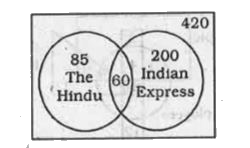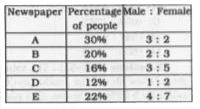In a survey of 60 people, it was found that 25 people read newspaper H. 26 read newspaper T, 26 read newspaper I, 9 read both H and I, 11 read both H and T, 8 read both T and I, 3 read all three newspaper. Find:
(i) the number of people who read at least one of the newspapers.
(ii) the number of people who read exactly one newspaper.
Let A be the set of people who read newspaper H.
Let B be the set of people who read newspaper T.
Let C be the set of people who read newspaper I.
Given n(A)=25,n(B)=26, and n(C)=26
n(A∩C)=9,n(A∩B)=11, and (B∩C)=8
n(A∩B∩C)=3
Let U be the set of people who took part in the survey.
(i) n(A∪B∪C)=n(A)+n(B)+n(C)
−n(A∩B)−n(B∩C)
−n(C∩A)+n(A∩B∩C)
=25+26+26−11−8−9+3
=52
Hence, 52 people read at least one of the newspaper.
(ii) Let a be the number of people who read newspapers H and T only.
Let b denote the number of people who read newspapers I and H only.
Let c denote the number of people who read newspaper T and I only.
Let d denote the number of people who read all three newspaper.
Accordingly, d=n(A∩B∩C)=3
Now, n(A∩B)=a+d
n(B∩C)=c+d
n(C∩A)=b+d
∴a+d+c+d+b+d=11+8+9=28
⇒a+b+c+d=28−2d=28−6=22
Hence, (52−22)=30 people read exactly one newspaper
Related Playlists
- BOOK - NCERTCHAPTER - SETSEXERCISE - EXERCISE 1.31videos
SETS
- BOOK - NCERTCHAPTER - SETSEXERCISE - SOLVED EXAMPLES4videos
SETS
- BOOK - NCERTCHAPTER - RELATIONS AND FUNCTIONSEXERCISE - EXERCISE 1.314videos
RELATIONS AND FUNCTIONS
- BOOK - NCERTCHAPTER - THREE DIMENSIONAL GEOMETRYEXERCISE - QUESTION1videos
THREE DIMENSIONAL GEOMETRY
Similar Questions
In a survey of 60 people, it was found that 25 people read newspaper H. 26 read newspaper T, 26 read newspaper I, 9 read both H and I, 11 read both H and T, 8 read both T and I, 3 read all three newspaper. Find:
(i) the number of people who read at least one of the newspapers.
(ii) the number of people who read exactly one newspaper.View SolutionIn a survey of 60 persons, it is found that 25 read newspaper H, 26 read T, 26 read I, 9 read H and I, 11 and H and T,8 read T and I and 3 read all three newspaper. Find :
(a) No. of persons who read atleast one newspaper.
(b) No. of persons who read exactly one newspaper.View SolutionFrom the details, find out the number of people who do not read any newspaper.
 View Solution
View SolutionThe table given below shows the percentage of people reading various newspapers in society. It also shows the ratio of males and females for each newspaper. Each person reads exactly one newspaper.
Total number of people in the society is 20000.

How many females read newspaper A?View SolutionThe number of people who read at least one type of magazine and are over 35 yr in age, is
View SolutionIn a colony of 200 members, 85 people read English newspaper, 53 people read Hindi newspaper and 120 read Telugu newspaper, 12 read newspapers of all the three languages, 21 read English and Hindi newspapers, 17 read Hindi and Telugu newspapers.
Find the number of people who read only of the newspapers.View SolutionIn a colony of 200 members, 85 people read English newspaper, 53 people read Hindi newspaper and 120 read Telugu newspaper, 12 read newspapers of all the three languages, 21 read English and Hindi newspapers, 17 read Hindi and Telugu newsapapers.
Find the numbers of people who read exactly 2 newspaper.View SolutionIn a colony of 200 members, 85 people read English newspaper, 53 people read Hindi newspaper and 120 read Telugu newspaper, 12 read newspapers of all the three languages, 21 read English and Hindi newspapers, 17 read Hindi and Telugu newspapers.
Find the number of people who read almost 2 newspapers.View SolutionIn a colony of 200 members, 85 people read English newspaper, 53 people read Hindi newspaper and 120 read Telugu newspaper, 12 read newspapers of all the three languages, 21 read English and Hindi newspapers, 17 read Hindi and Telugu newspapers. and 52 read telugu and english news paperr
Find the number of people who read only one of the newspapers.View SolutionIn a colony of 200 members, 85 people read English newspaper, 53 people read Hindi newspaper and 120 read Telugu newspaper, 12 read newspapers of all the three languages, 21 read English and Hindi newspapers, 17 read Hindi and Telugu newspapers.and 52 read telugu and english news paperr
Find the number of people who read almost 2 newspapers.View Solution


